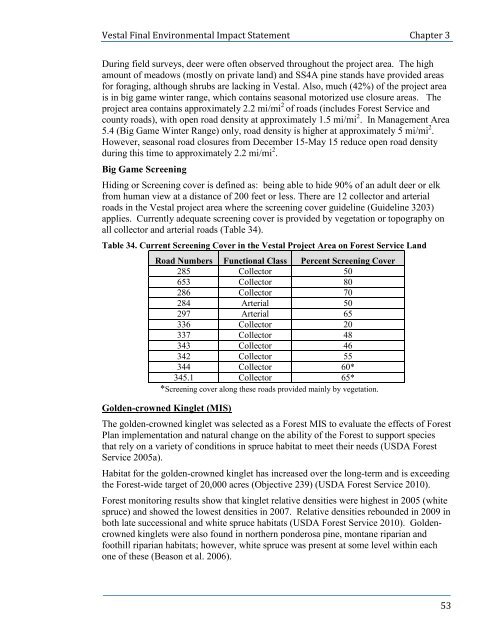Final Environmental Impact Statement
Final Environmental Impact Statement
Final Environmental Impact Statement
You also want an ePaper? Increase the reach of your titles
YUMPU automatically turns print PDFs into web optimized ePapers that Google loves.
Vestal <strong>Final</strong> <strong>Environmental</strong> <strong>Impact</strong> <strong>Statement</strong> Chapter 3<br />
During field surveys, deer were often observed throughout the project area. The high<br />
amount of meadows (mostly on private land) and SS4A pine stands have provided areas<br />
for foraging, although shrubs are lacking in Vestal. Also, much (42%) of the project area<br />
is in big game winter range, which contains seasonal motorized use closure areas. The<br />
project area contains approximately 2.2 mi/mi 2 of roads (includes Forest Service and<br />
county roads), with open road density at approximately 1.5 mi/mi 2 . In Management Area<br />
5.4 (Big Game Winter Range) only, road density is higher at approximately 5 mi/mi 2 .<br />
However, seasonal road closures from December 15-May 15 reduce open road density<br />
during this time to approximately 2.2 mi/mi 2 .<br />
Big Game Screening<br />
Hiding or Screening cover is defined as: being able to hide 90% of an adult deer or elk<br />
from human view at a distance of 200 feet or less. There are 12 collector and arterial<br />
roads in the Vestal project area where the screening cover guideline (Guideline 3203)<br />
applies. Currently adequate screening cover is provided by vegetation or topography on<br />
all collector and arterial roads (Table 34).<br />
Table 34. Current Screening Cover in the Vestal Project Area on Forest Service Land<br />
Road Numbers Functional Class Percent Screening Cover<br />
285 Collector 50<br />
653 Collector 80<br />
286 Collector 70<br />
284 Arterial 50<br />
297 Arterial 65<br />
336 Collector 20<br />
337 Collector 48<br />
343 Collector 46<br />
342 Collector 55<br />
344 Collector 60*<br />
345.1 Collector 65*<br />
*Screening cover along these roads provided mainly by vegetation.<br />
Golden-crowned Kinglet (MIS)<br />
The golden-crowned kinglet was selected as a Forest MIS to evaluate the effects of Forest<br />
Plan implementation and natural change on the ability of the Forest to support species<br />
that rely on a variety of conditions in spruce habitat to meet their needs (USDA Forest<br />
Service 2005a).<br />
Habitat for the golden-crowned kinglet has increased over the long-term and is exceeding<br />
the Forest-wide target of 20,000 acres (Objective 239) (USDA Forest Service 2010).<br />
Forest monitoring results show that kinglet relative densities were highest in 2005 (white<br />
spruce) and showed the lowest densities in 2007. Relative densities rebounded in 2009 in<br />
both late successional and white spruce habitats (USDA Forest Service 2010). Goldencrowned<br />
kinglets were also found in northern ponderosa pine, montane riparian and<br />
foothill riparian habitats; however, white spruce was present at some level within each<br />
one of these (Beason et al. 2006).<br />
53

















